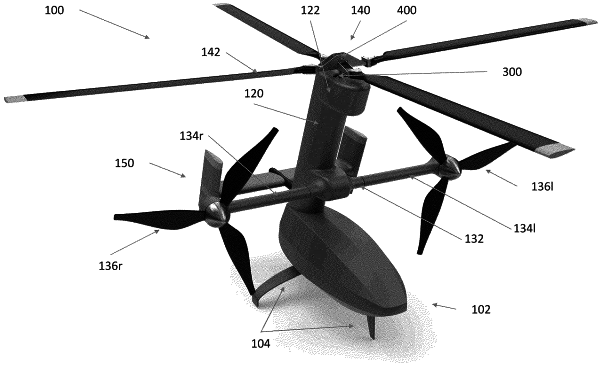| CPC B64C 29/0033 (2013.01) [B64C 27/02 (2013.01); B64C 27/025 (2013.01); B64C 27/32 (2013.01); B64C 27/57 (2013.01); B64C 27/59 (2013.01); B64C 27/625 (2013.01); B64C 27/64 (2013.01); B64C 27/82 (2013.01); B64D 27/24 (2013.01); B64D 31/00 (2013.01); B64D 35/02 (2013.01); B64C 2027/8236 (2013.01); G05D 1/102 (2013.01)] | 16 Claims |

|
1. An aircraft comprising:
a rotor configured to provide lift;
a first proprotor laterally displaced relative to a longitudinal axis of the aircraft and configured to produce thrust substantially parallel to the longitudinal axis;
a second proprotor laterally displaced relative to the longitudinal axis of the aircraft, the second proprotor disposed on an opposite side of the of the longitudinal axis from the first proprotor and configured to produce thrust substantially parallel to the longitudinal axis;
one or more motors configured to power the rotor, the first proprotor, and the second proprotor; and
control circuitry in communication with the one or more motors and configured to control the aircraft in a vertical takeoff or landing mode by causing the one or more motors to at least:
drive the rotor to provide lift;
drive the first proprotor in a forward direction; and
drive the second proprotor in a reversed direction, such that the first proprotor and the second proprotor counteract a torque created by the rotor;
wherein the control circuitry is further configured to transition the aircraft from the vertical takeoff or landing mode to a forward flight mode by at least:
causing the one or more motors to stop driving the second proprotor in the reverse direction;
causing the one or more motors to increase a rotational speed of the first proprotor in the forward direction while a reverse thrust created by the second proprotor decreases to zero;
causing the one or more motors to drive the second proprotor in the forward direction to provide forward thrust; and
causing the one or more motors to stop driving the rotor such that the rotor is allowed to rotate by autorotation.
|